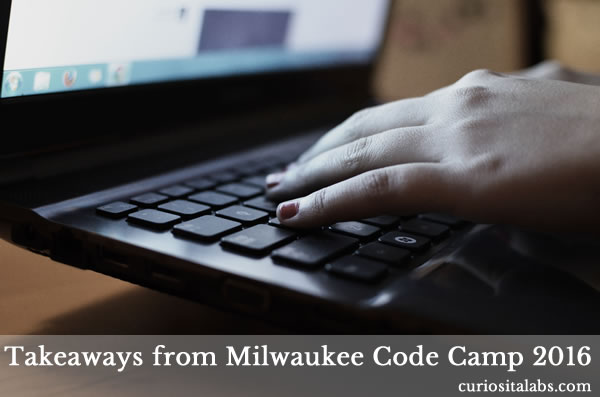What is Milwaukee Code Camp? A one day conference with a wide variety of presentations and talks on coding, technology and more. I attended the sessions on Design Patterns, Firebase, HoloLens and Building a Chat Bot. Here are my notes:

Design Patterns
David showed us how to make your code adaptable, separate concerns and apply an interface and different design patterns. He started with code that was written without the benefit of an interface. David showed why this design wasn’t as adaptable to changes as it needed to be. You couldn’t add a new back-end provider without rewriting the code.
David showed us four Design Patterns. They are:
- Bridge Pattern: use an interface to separate dependency from code
- Decorator Pattern: wrap one object inside of another
- Chain of Responsibility: passes through a series of handler until it can process your request
- Template Pattern: it handles repeated code (an algorithm)
David explained that you should use patterns when they make sense. Not all situations are appropriate for a design pattern. You can download the code and check out the slides for Design Patterns on github.
Firebase
Firebase is a noSQL database. It is a realtime database which has a cloud-based backend. With Firebase, you can build high-quality apps. It has APIs package into a single SDK for easy use. As a Google product, can use AD Works and Analytics to learn what your users need. It works across multiple platforms from iOS to JavaScript.
You may want to consider Firebase for your app if:
- You’re building a new app or rebuilding an existing one.
- Your application requires minimal integration with third party services or legacy systems.
- You’re creating an app that doesn’t have complex user authentication needs or heavy data processing requirements.
To get started, sign up for a Firebase account. Create a project, then setup authentication because it is in active at first. Then, you can start creating your app. If you want, you can use it with a Facebook app. You can learn more about Firebase from Google.
HoloLens
HoloLens uses both augmented and mixed reality. They defined augmented as supplemental to reality. PokeMon Go is an example of augmented reality. Mixed is where you add objects to reality. Greg Levenhagen talked about how Microsoft is leading the way with augmented reality by providing HoloLens as a tool for creating revolutionary apps and games. We discussed how HoloLens can be used for engineering, training, manufacturing, sales and remote communications. Right now, C# developers can start building apps for HoloLens today.
You Can Build a Bot, too!
A chat bot that is. A chat bot is an app that simulates a human conversation. They can tell you the weather or find an article for you. “Chat bots are becoming the new apps.” Big tech companies like Google, Apple, Facebook and Slack have chat bots. You can order tacos from Taco Bell in Slack using a chat bot.
When you create a chat bot, you want it to have:
- A simple and uncomplicated user interface.
- A specific purpose and complete specific tasks.
- A personality. Is it snarky or formal?
- A reliable hosting service. You want your bot to be available all day.
- A “catch all” response when it doesn’t know something. It may refer you to a website or a person who can answer the question.
- Be well tested. A buggy chat bot will not be used.
Anthony Jesmok, a Full Stack Developer with Misix, explained that you can get started with your own chat bot. There are several bot frameworks to choose from. For his presentation, he used the Microsoft Bot Framework, Microsoft LUIS (a natural language recognition engine) and Node.js. With Microsoft LUIS, you create an app recognizes and handles the situations (functions) that you what the chat bot do. Anthony has made his code and slides available on github.
Summary
As with other conferences, it can be hard to choose between sessions to go to. I have new and interesting technologies and coding techniques to learn more about. Thanks to the sponsors: Skyline Technologies, SafeNet, Concurrency and University of Wisconsin – Milwaukee for making a great conference.
